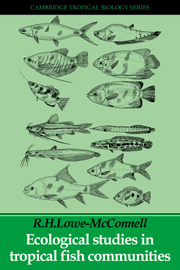Book contents
- Frontmatter
- Contents
- Preface
- Acknowledgements
- PART I INTRODUCTION
- PART II FRESHWATER STUDIES
- PART III MARINE FISH STUDIES
- PART IV SYNTHESES
- 11 Responses of fishes to conditions in tropical waters
- 12 Trophic interrelationships
- 13 Diversity: its maintenance and evolution
- 14 The exploitation and conservation of tropical fish stocks
- Appendix: Fish families in tropical waters
- References
- Index
11 - Responses of fishes to conditions in tropical waters
Published online by Cambridge University Press: 07 May 2010
- Frontmatter
- Contents
- Preface
- Acknowledgements
- PART I INTRODUCTION
- PART II FRESHWATER STUDIES
- PART III MARINE FISH STUDIES
- PART IV SYNTHESES
- 11 Responses of fishes to conditions in tropical waters
- 12 Trophic interrelationships
- 13 Diversity: its maintenance and evolution
- 14 The exploitation and conservation of tropical fish stocks
- Appendix: Fish families in tropical waters
- References
- Index
Summary
Ecological attributes of tropical fish communities considered in earlier chapters are summarized here and in Table 11.1. There are of course many exceptions to such broad generalizations, but they are made here as a framework to stimulate further study.
Phyletic patterns. Phylogenetically different types of fishes dominate the various communities. Riverine communities are dominated by otophysan fishes (primary freshwater fishes), together with other endemic primary freshwater fish families in African rivers; lacustrine communities are dominated by secondary freshwater fishes, cichlids in the littoral zone, clupeids and their centropomid predators in the pelagic zone. In the sea, clupeoids and their acanthopterygian predators abound in upwelling areas, while reef communities are dominated by acanthopterygian fishes able to manoeuvre backwards into crevices, with jaws and teeth capable of exploiting the very varied food resources, finspines and poisons protecting the fish from the numerous piscivores. A diverse group, primarily acanthopterygians (sciaenids, grunts, sparids, snappers) live demersally on the continental shelves. There is also an apparent relationship between phylogenetic position and temporal habits (Hobson, 1974): the more generalized teleosts (such as percomorphs) are typically large mouthed nocturnal or crepuscular carnivores, while many advanced fishes have specialized towards diurnality and feeding on smaller animals and plants. Ontogenetic changes may also occur, for example juveniles feeding diurnally then switching to nocturnal feeding with increased size.
[…]
- Type
- Chapter
- Information
- Ecological Studies in Tropical Fish Communities , pp. 235 - 269Publisher: Cambridge University PressPrint publication year: 1987



